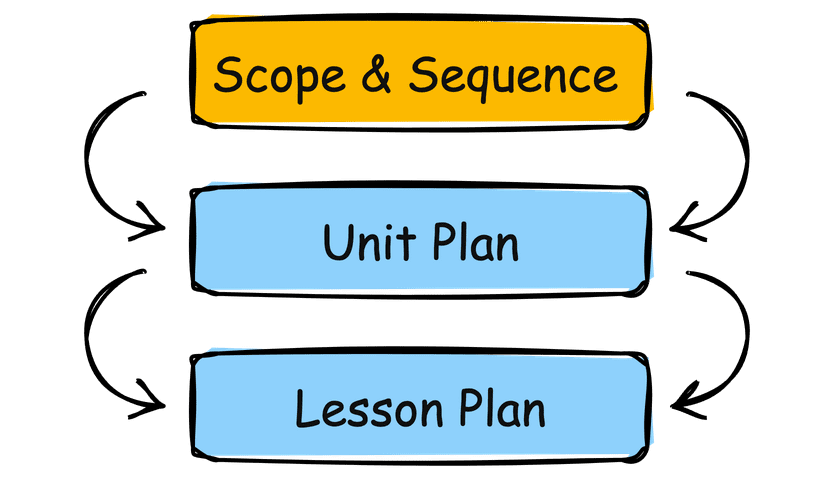Education is a journey, and just like any journey, it requires a clear roadmap. That roadmap in education is known as a scope and sequence. A well-designed scope and sequence serves as the backbone of effective curriculum planning and instructional delivery. It outlines the essential skills, concepts, and content that students should master, ensuring a logical progression of learning from one grade level to the next. Let’s delve into why scope and sequence matters, how to create one, and its impact on student success.

Why Scope and Sequence Matters:
- Coherent Learning Progression: A scope and sequence ensures that learning builds upon prior knowledge, preventing gaps or redundancies in students’ understanding.
- Curriculum Alignment: It aligns curriculum with educational standards and goals, guaranteeing that the intended outcomes are achieved.
- Consistency: It offers a consistent learning experience, regardless of teacher or classroom, fostering equity in education.
- Effective Planning: Teachers can plan lessons with a clear sense of direction, focusing on what’s essential and relevant.
- Student Achievement: A well-structured scope and sequence contribute to improved student achievement by providing a solid foundation for learning.
Creating an Effective Scope and Sequence:
- Identify Learning Objectives: Start with educational standards and learning objectives for each grade level. Determine the skills and knowledge students should gain.
- Sequence Content: Organize content in a logical order, considering prerequisites and building complexity as students progress.
- Map Out Timelines: Estimate the time required for each topic or unit, ensuring a balanced distribution across the school year.
- Integrate Cross-Curricular Connections: Look for opportunities to integrate subjects, enhancing students’ understanding of how knowledge is interconnected.
- Assessment Alignment: Align assessments with the scope and sequence to evaluate students’ mastery of essential concepts.
Impact on Student Success
A well-crafted scope and sequence have a profound impact on student success. It:
- Provides a clear pathway for skill development.
- Supports differentiated instruction to meet diverse student needs.
- Fosters a deeper understanding of concepts, as students connect ideas over time.
- Enables educators to monitor student progress more effectively.
- Sets a foundation for vertical alignment, ensuring seamless transitions between grade levels.
By embracing a thoughtful scope and sequence, educators empower their students to embark on a meaningful educational journey, equipped with the knowledge and skills needed for success.
FAQs
1. What exactly is a scope and sequence? A scope and sequence is an educational roadmap that outlines the learning goals, concepts, and skills students will cover within a specific subject over a defined period, often a school year.
2. How does a scope and sequence enhance instruction? A well-structured scope and sequence ensures that educators teach in a coherent and logical order, building on students’ prior knowledge and setting them up for success in subsequent years.
3. Can a scope and sequence be adapted for different classrooms? Absolutely! While the core content remains consistent, teachers can adapt the delivery and pace to suit their students’ needs and their teaching style.
4. How does a scope and sequence align with standards? A scope and sequence aligns with educational standards by mapping out the skills and knowledge required at each grade level, ensuring that curriculum content meets established benchmarks.
5. What benefits does a scope and sequence offer students? A scope and sequence provides students with a clear roadmap of their learning journey, ensuring they acquire essential skills, concepts, and knowledge, setting them up for academic success.
6. How often should a scope and sequence be reviewed and updated? A scope and sequence should be reviewed periodically, ideally at the end of each school year, to reflect any changes in standards, educational goals, or instructional needs.
7. Can a scope and sequence accommodate different teaching approaches? Yes, a well-designed scope and sequence can accommodate various teaching approaches, ensuring flexibility while maintaining the integrity of the learning progression.
8. Is a scope and sequence limited to core subjects? A scope and sequence can be applied to all subjects, including core and elective courses, as well as extracurricular programs, to ensure a comprehensive educational experience for students.
9. How can educators use a scope and sequence for differentiation? Educators can use a scope and sequence to identify areas where students may need additional support or challenges, enabling them to tailor instruction to meet individual learning needs.
10. Can a scope and sequence be shared with parents? Absolutely. Sharing a scope and sequence with parents provides transparency about the curriculum and helps parents support their children’s learning at home.
Incorporating a well-crafted scope and sequence into educational planning is like providing students with a map for their learning journey, guiding them toward academic achievement and success.





